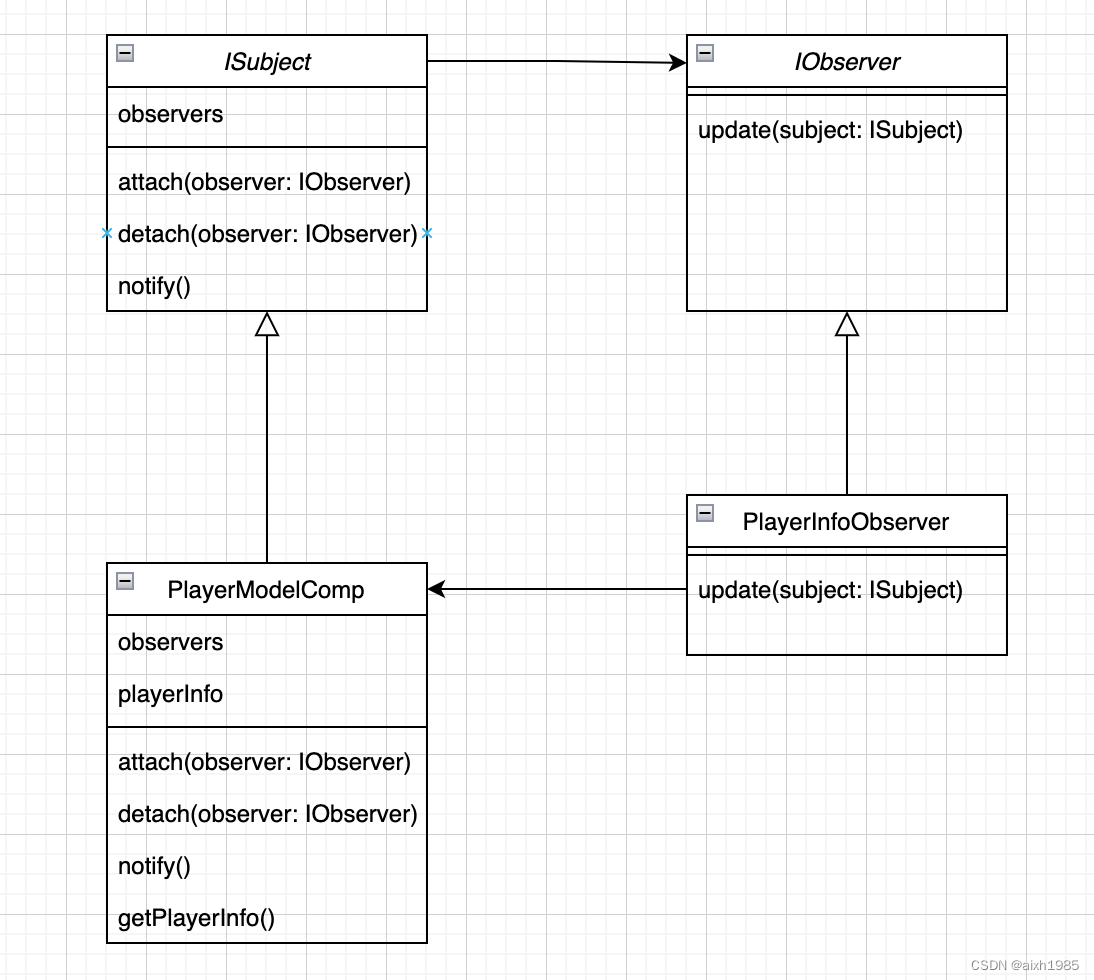用23种设计模式打造一个cocos creator的游戏框架----(十四)观察者模式
2023-12-13 05:10:49
1、模式标准
模式名称:观察者模式
模式分类:行为型
模式意图:定义对象间的一种一对多的依赖关系,当一个对象的状态发生改变时,所有依赖于它的对象都得到通知并被自动更新。
结构图:

适用于:
1、当一个抽象模型有两个方面,其中一个方面依赖于另一个方面,将这两者封装在独立的对象中以使它们可以各自独立地改变和复用。
2、当对一个对象的改变需要同时改变其他对象,而不知道具体有多少对象有待改变时。
3、当一个对象必须通知其他对象,而它又不能假定其他对象是谁,即不希望这些对象是紧耦合的?
2、分析与设计?
观察者模式的主要使用场景是gui、网络服务器、发布订阅系统。在前面的设计模式中,我们采用了代理模式,通过“代理拦截修改”实现了数据层和视图层之间的响应式。虽然实现了响应式,但是其中的数据不是真实的数据源。真实数据源发生变化时,还需要通过xhgame.vm.gateVM.ps = 123来手动触发修改。我们希望的数据自动监听真实数据源的变化自动触发响应式。下面我们通过观察者模式来实现它,在游戏框架里我们统一使用modelComp中的数据源,先修改一下我们的意图
意图:定义对象(modelComp)间的一种一对多的依赖关系,当一个对象(modelComp)的状态发生改变时,所有依赖于它的对象都得到通知并被自动更新。
3、开始打造

主题接口
export interface ISubject {
observers: IObserver[]
attach(observer: IObserver): void
detach(observer: IObserver): void
notify(): void
}观察者接口
export interface IObserver {
update(subject: ISubject): void
}这里新增一个modelComp?的抽象类继承之前的ecs中Comp
export abstract class ModelComp<T> extends Comp implements ISubject {
callback: Function = null
reset(): void {
}
onAttach(entity: Entity) {
}
onDetach(entity: Entity) {
}
// 观察者模式
observers: IObserver[] = []
attach(observer: IObserver): void {
const isExist = this.observers.includes(observer);
if (isExist) {
return console.log('已存在监听者');
}
this.observers.push(observer);
}
detach(observer: IObserver): void {
const observerIndex = this.observers.indexOf(observer);
if (observerIndex === -1) {
return console.log('不存在监听者');
}
this.observers.splice(observerIndex, 1);
}
notify(): void {
console.log('ModelSubject notify')
for (const observer of this.observers) {
observer.update(this);
}
}
}接着是具体的主题,玩家的modelComp
export class PlayerModelComp extends ModelComp<IPlayerInfo_JCQ> {
callback: Function = null
_playerInfo: IPlayerInfo_JCQ = {
id: 0,
openid: '',
server_no: '',
platform: '',
ps: 0,
gold: 0,
diamond: 0,
last_battle_id: 0
}
get playerInfo() {
return this._playerInfo
}
set playerInfo(val) {
this._playerInfo = val
this.notify()
}
reset() {
this.callback = null
this._playerInfo = {
id: 0,
openid: '',
server_no: '',
platform: '',
ps: 0,
gold: 0,
diamond: 0,
last_battle_id: 0
}
//
this.observers = []
}
onAttach(entity: Entity) {
this.callback && this.callback()
}
onDetach(entity: Entity) {
}
}设置一个玩家信息的监听者
export class PlayerInfoObserver implements IObserver {
update(subject: PlayerModelComp): void {
const playerInfo = subject.playerInfo
xhgame.vm.gateVM.ps = playerInfo.ps
xhgame.vm.gateVM.gold = playerInfo.gold
xhgame.vm.gateVM.diamond = playerInfo.diamond
}
}4、开始使用
export class JCQPlayerEntity extends Entity {
model: PlayerModelComp
init() {
this.model = this.attachComponent(PlayerModelComp)
}
}对playerModelComp添加多个监听者?
xhgame.game.playerEntity.model.attach(new PlayerInfoObserver())
xhgame.game.playerEntity.model.attach(new OtherObserver())观察者内原本有自己的state或者info,现在用了vm来代替了
export class PlayerInfoObserver implements IObserver {
update(subject: PlayerModelComp): void {
const playerInfo = subject.playerInfo
xhgame.vm.gateVM.ps = playerInfo.ps
xhgame.vm.gateVM.gold = playerInfo.gold
xhgame.vm.gateVM.diamond = playerInfo.diamond
}
}
文章来源:https://blog.csdn.net/u010192444/article/details/134956460
本文来自互联网用户投稿,该文观点仅代表作者本人,不代表本站立场。本站仅提供信息存储空间服务,不拥有所有权,不承担相关法律责任。 如若内容造成侵权/违法违规/事实不符,请联系我的编程经验分享网邮箱:veading@qq.com进行投诉反馈,一经查实,立即删除!
本文来自互联网用户投稿,该文观点仅代表作者本人,不代表本站立场。本站仅提供信息存储空间服务,不拥有所有权,不承担相关法律责任。 如若内容造成侵权/违法违规/事实不符,请联系我的编程经验分享网邮箱:veading@qq.com进行投诉反馈,一经查实,立即删除!